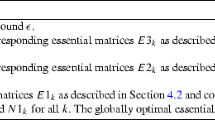Abstract
This paper deals with the exploitation of the epipolar constraint information for the construction of the essential matrix (fundamental matrix for uncalibrated images), which, once decomposed, solves the structure from motion problem. This technique has been longly considered inferior to the techniques which use the optical flow information, because of its high sensitivity to noise. The approach used here, which is particularly robust to noise, both demonstrates the validity and presents an extension of the essential matrix approach. Once established the fact that the problem at hand is Total Least Squares (TLS) with a certain structure, a statistical analysis of the problem suggests the use of the Constrained TLS in order to take in account the linear dependences of the noise components in the coefficients. This leads to the CTLS and CTLSn EXIN neurons which are simple variants (change of metrics) of the TLS EXIN linear neuron which solves the basic TLS problem. These neurons are able to yield good results even in the presence of an outlier contamination of half the point matches.
Access this chapter
Tax calculation will be finalised at checkout
Purchases are for personal use only
Preview
Unable to display preview. Download preview PDF.
Similar content being viewed by others
References
T.J. Abatzoglou and J.M. Mendel. Constrained total least squares. Proc. ICASSP, pages 1485–1488, 1987.
T.J. Abatzoglou, J.M. Mendel, and G.A. Harada. The constrained total least squares technique and its application to harmonic superresolution. IEEE Trans. Signal Processing, 39 (5): 1070–1087, May 1991.
F. Bookstein. Fitting conic sections to scattered data. Computer Vision, Graphics and Image Processing, 9: 56–71, 1979.
S. Chaudhuri and S. Chatterjee. Performance analysis of total least squares methods in three-dimensional motion estimation. IEEE Trans. On Robotics and Automation, 7 (5): 707–714, October 1991.
S. Chaudhuri, S. Sharma, and S. Chatterjee. Recursive estimation of motion parameters. Computer Vision and Image Understanding, 64 (3): 434–442, November 1996.
G. Cirrincione. A Neural Approach to the Structure from Motion Problem. PhD thesis, LIS INPG Grenoble, December 1998.
G. Cirrincione. Neural minor component analysis and tls. In S. Van Huffel and P. Lemmerling, editors, Total Least Squares and Errors-in-Variables Modeling: Analysis, Algorithms and Applications, 2002.
G. Cirrincione and M. Cirrincione. Linear system identification using the tls exin neuron. In NEURAP 98, Marseille ( France ), March 1998.
G. Cirrincione and M. Cirrincione. Robust neural approach for the estimation of the essential parameters in computer vision. International Journal on Artificial Intelligence Tools, 8 (3), September 1999.
R.I. Hartley. In defense of the eight-point algorithm. IEEE Transactions on Pattern Analysis and Machine Intelligence, 19(6):580–593, June 1997.
S. Van Huffel and J. Vandewalle. The Total Least Squares Problems: Computational Aspects and Analysis. Frontiers in Applied Mathematics. SIAM Philadelphia, 1991.
K. Kanatani. Geometric Computation for Machine Vision. The Oxford engineering science series. Clarendon Press Oxford, 1993.
Q.T. Luong, R. Deriche, O. Faugeras, and T. Papadopoulo. On determining the fundamental matrix: Analysis of different methods and experimental results. Technical Report 1894, INRIA, April 1993.
M. Muhlich and R. Mester. The role of total least squares in motion analysis. In H. Burkhardt, editor, Proc. European Conf. Computer Vision, pages 305–321. Springer Lecture Notes on Computer Science, June 1998.
P.H.S. Torr and D.W. Murray. The development and comparison of robust methods for estimating the fundamental matrix. International Journal of Computer Vision, 24 (3): 271–300, 1997.
J. Weng, T.S. Huang, and N. Ahuja. Motion and Structure from Image Sequences. Springer Series in Information Sciences. Springer-Verlag, 1993.
Author information
Authors and Affiliations
Editor information
Editors and Affiliations
Rights and permissions
Copyright information
© 2002 Springer Science+Business Media Dordrecht
About this chapter
Cite this chapter
Cirrincione, G. (2002). TLS and Constrained TLS Neural Networks for Computer Vision. In: Van Huffel, S., Lemmerling, P. (eds) Total Least Squares and Errors-in-Variables Modeling. Springer, Dordrecht. https://doi.org/10.1007/978-94-017-3552-0_34
Download citation
DOI: https://doi.org/10.1007/978-94-017-3552-0_34
Publisher Name: Springer, Dordrecht
Print ISBN: 978-90-481-5957-4
Online ISBN: 978-94-017-3552-0
eBook Packages: Springer Book Archive




